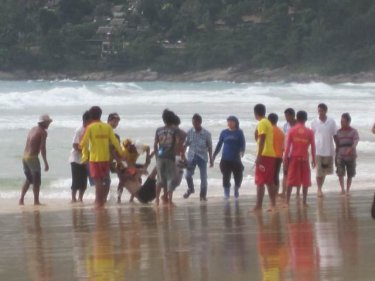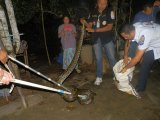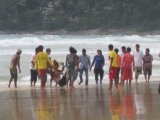This week's Phuket beach death toll now stands at three drownings in five days.
Non-swimmer Panyo, 17, and two friends were swept off their feet about 4pm and carried beyond their depth.
One person was saved when he was able to stand on a sandbar and await rescue. A jet-ski plucked the other Burmese from the water safely, a lifeguard spokesperson said.
But Panyo was dead when fetched ashore to the beach opposite the South Sea Karon Resort, between Karon Circle and the Hilton Phuket Arcadia Resort and Spa.
The lifeguard spokesperson said that red flags were flying along Karon and other Phuket beaches yesterday, to signify a no-swimming day.
''Lifeguards were blowing their whistles all day trying to keep people out of the water,'' she said. ''It's just not possible to control the whole shorefront, especially at long beaches like Karon.''
Winds were whipping the waves too high all along Phuket's west coast, the spokesperson said.
The young Burmese worker's drowning yesterday was the latest in a series of drownings at popular Phuket beaches this week.
Russian tourist Alexey Tsymbalyuk, 45, drowned at Patong, the popular beach north of Karon, on Tuesday.
Well-known Thai graphic artist Pharuephon ''Mamafaka'' Mukdasanit, 34, died in a Phuket hospital on Monday after being pulled unconscious from the water at Kata beach, south of Karon, on Saturday.
The three deaths take the tally of beach drownings on Phuket close to 30 for the year so far. A tourist from Singapore was also pulled from the water, having gone swimming while drunk this week at Surin beach.
No official beach death figures have been released since April last year, when the Phuket Health Department ceased issuing regular monthly statistical updates on Phuket drownings and the road toll.
A marine safety summit has been proposed for October on Phuket, with the backing of the Phuket administration and the support of the British Embassy.
Envoys from China and other countries have become perturbed at the rising number of deaths on Phuket's beaches and on snorkelling day-trips.
Lifeguards say they are undermanned and cannot prevent people from going into the water without more warnings being issued by resorts as people arrive, with the help of local councils.
An increase in tourists to Phuket coming from China, Russia and other countries where beach safety is not well known is being blamed for the rise in drownings.
Safety experts say resorts that benefit from the revenue delivered by Phuket's year-round beach tourism should warn their guests about the dangers in the water.













A recent conversation with a guest in our hotel on a day with high and dangerous waves:
Guest: Is the ocean OK to swim?
Reception: I am very sorry sir but we don't recommend to swim in the ocean when waves are strong, please see the red flags and warning from the lifeguards on duty. Also please take a look at our warning about rip currents. But if you like to go swimming, we have 6 pools on the property.
Guest: But there are red flags everywhere, why I can't go swimming in the ocean?
Reception: I am really sorry sir but the ocean is very dangerous at that time of the year.
Guest: So there is no swimming area in your bay? You can't mark the safe areas?
Reception: Unfortunately all the coastline is effected. When the waves are high and rip currents strong we can't recommend to swim in the ocean sir.
Guest: But I came for a beach-vacation! Can you please confirm to me now that I can go swimming?!
Reception: Sorry sir, we can't do that. We recommend you to use the pool instead.
Guest: But I want to go to the ocean!
Posted by Jakub on September 20, 2013 10:44
Editor Comment:
That's why there must be warnings at the airport on arrival, in-person information delivered on check-in, and signs in every resort specifying whether it's safe or not to swim. Lifeguards are the last chance. Resort managements should also be examining whether their promotional material for holidays on Phuket should be more specific. Some resorts already take precautions. Others do not. They must.